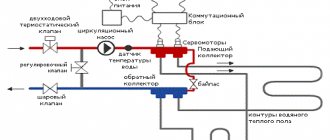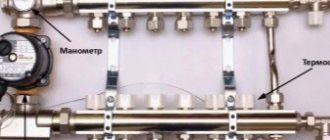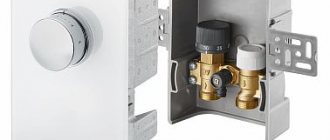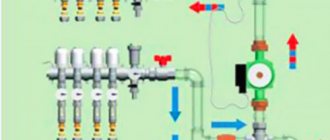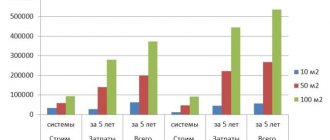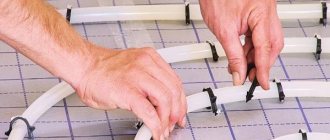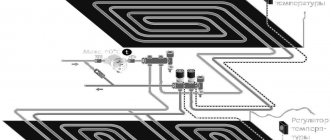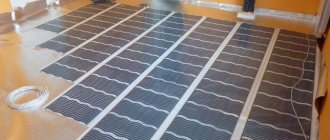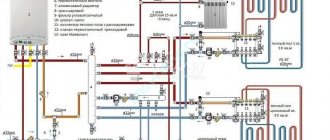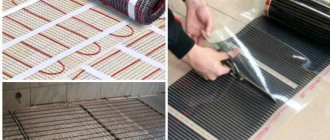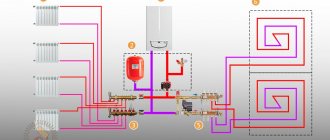The pumping and mixing unit and the manifold group of the water heated floor are designed to regulate the circulation of the coolant in the circuits, control the pressure in the heating system, eliminate air pockets and control the temperature. How the manifold for a heated floor is assembled, the basic connection diagrams and common mistakes, we will consider further. You can read about the device and principle of operation here
Why do you need a heated floor collector?
The “water heated floor” system is an effective way to uniformly heat all rooms in the house. Installation of this type of heating without a collector group is possible provided that a single circuit is laid. However, the maximum possible length of one pipe should not exceed 70 m, which effectively covers seven square meters. Thus, on average, a minimum of 2 circuits will be required per room.
Pumping and mixing unit with a minimum number of circuits
When laying water heated floors simultaneously in several rooms without turning on the collector, it will be impossible to regulate the main indicators of the correct operation of the heating system. The absence of a collection group is fraught with serious problems:
- Inability to regulate pressure in the heating system and bleed air;
- If the water heated floor pipe is damaged, you will have to turn it off completely in the entire house;
- Uneven heating of the premises of the house.
Improper functioning of the system will lead to costly repairs. If you have some skills, it is possible to install the unit without involving specialists. It is enough to purchase a manifold group that matches the parameters of the pumping and mixing unit and connect them in compliance with the technology.
What does a heated floor manifold consist of?
The control system for a water heated floor is a combination of valves, sensors, actuators and other elements. The principle of operation of the collector is simple - the heated coolant passes through the circuits, cooling and returning to the starting point for reheating. The design mixes circulating liquid of different temperatures, which allows you to obtain optimal parameters for heated floors.
A standard mixing and distribution unit for a heated floor assembly consists of:
- Mixing unit (1) for diluting hot water from the boiler. Mixing occurs automatically due to the presence of temperature sensors and a servo drive used as a thermostat.
- Circulation pump (2) on the coolant supply pipe. The pump provides the system with the correct pressure to improve heating efficiency;
- Distribution comb (collector group) (3), equipped with outlets for connecting water circuits and flow meters for zonal distribution of circulating fluid through pipes. As well as a bypass (5) to prevent overheating of the pump.
Design and principle of operation of the collector
The manifold, or comb as it is also called, is included in the mixing unit kit. Without this device it is difficult to imagine a normally functioning heated floor. Without this device, the whole point of heating through underfloor heating is lost. Being the most important element of the mixing unit, the manifold ensures the mixing of water flows of different temperatures and their subsequent distribution through the heating pipes of the water circuit. Essentially, the device consists of two similar parts, one part is the supply part, while the other is the collecting part. Hence the name, which is common among specialists, distribution comb.
For reference: the distribution part is the unit for supplying warm water to the underfloor heating pipeline system. The collecting part is specially designed to collect waste coolant flowing in the opposite direction (return).
Structurally and externally, both parts are practically no different. The device is based on a large diameter tube equipped with threaded side branches (holes). The number of holes corresponds to the number of water circuits connected to the equipment. In simple terms, a comb is tees with the same parameters, twisted together. Therefore, for those who have at least some idea about plumbing, making a homemade manifold will not involve a pipe.
Having an idea of what a collector is and what its main tasks are, you can start planning your own heating system. In order to make a distributor, you need to know in advance how large the heated room will be and what your heating needs are. Therefore, decide the following questions for yourself:
- how many heating circuits will you have;
- what type will be the main source of water heating (we are talking about either a central heating and hot water system, or an autonomous boiler);
- what additional devices and devices will be equipped with the heating system (pump, temperature sensors, pressure gauges).
Note: you need to start making a heated floor collector with your own hands by choosing the design of the device. In other words, it is necessary to decide how the water pipes will be connected, and accordingly in what position the distribution and collecting combs will be located.
There are a lot of technological nuances that you should pay attention to before you start assembling your device.
For example, gas or electric heating devices are connected to the collectors from below or from above. When installing a circulation pump in the system, the connection will only be at the end of the comb.
In cases where you use an indirect heating boiler or solid fuel boilers as a heating device, the collector can only be connected from the end.
If you want to use water from the central heating system to operate heated floors, your collector must be connected from above or below. The diagram shows an option for connecting the collector to the riser of the central heating system.
If it’s not difficult for you, transfer the design diagram and the position of the distribution combs onto paper. At the same time, you can specify the dimensional parameters that you can rely on during the work process. It is appropriate to say here that the distance between the individual supply and return pipes should be at least 10 cm and no more than 20 cm. The same dimensions can also be used for the distance between the individual units, the collection comb and the distributor.
Note: Try to make your device not only efficient and technologically advanced, but also compact. Otherwise, you may later face the problem of installing a homemade collector. An oversized device is more difficult to hide in a collector box, and installation of a heated floor collector will negatively affect the interior of the heated room.
After drawing up a sketch, it will become clear how much and what you will need for further work on making a homemade switchgear.
Accessories for water heated floors
The complex design of the mixing unit and collector group is complemented by many auxiliary parts that play one or another role in regulating the operation of warm water floors:
- The thermostatic valve is controlled manually or automatically using an electrothermal drive.
- Hydraulic balancing of the loops of the underfloor heating system occurs through tuning valves (there are options with or without flow meters).
- Ensuring constant pressure is achieved using an overflow valve, which redirects excess liquid to the bypass.
- The radiator balancing shut-off valve is used to open/close the water supply between the collector and the heating system.
- A bypass with a bypass valve, an expansion tank, a safety valve, as well as communicators and controllers are responsible for the trouble-free operation of water-heated floors and continuous monitoring of the operation of the heating system.
The mixing unit may have two or three way mixing valves. The first option is considered more reliable, as it allows you to limit the flow of water directly from the boiler using a balancing valve and thermostatic control units. This protects the circuit from exposure to boiling water, which is especially valuable when using polypropylene pipes.
The 3-way valve design is more versatile in terms of recommended heating area. Unlike two-way units, which cannot serve more than 200 m², a three-way valve creates optimal pressure in heated floors of any size.
Purpose of valves
A two-way valve can only allow water to flow in one direction, but its flow capacity is low. Its main advantage is the smooth supply of coolant. Modern models have a servo drive, which allows you to precisely adjust the throughput hole; this is done using a motor and a valve position sensor.
Two-way valves have a small capacity, so they can be used in rooms whose area does not exceed 200 m2.
A three-way valve can mix and separate water flows, which is why it is also called a mixing valve. It has three pipes, one where water comes from the boiler, another where it is supplied to the system, and one where the return flows and mixes it again with hot water. Such elements are installed in autonomous heating systems at the outlet of the collector.
During operation of the heated floor, the valve becomes clogged and for ease of replacement, a detachable coupling is used.
Assembly of the finished kit
The simplest and most reliable way, but more expensive, is to buy a ready-made set of pumping and mixing unit and manifold group. The assembly manual for the factory kit contains step-by-step instructions, allowing even an inexperienced craftsman to assemble it with his own hands.
Assembling a complete set of pumping and mixing unit and manifold group
The connection of underfloor heating pipes to the collector is made taking into account the throughput of the distribution combs and a drawn up diagram indicating the sizes of the pipes, their connection points with the elements of the heating system and the places of installation. Work on connecting the water circuit is carried out after installing the collector and protection system (bypass, air valve).
Materials and tools
The set of materials and tools for arranging a heating system is as follows:
- Boiler;
- Collector;
- Pump;
- Control valve;
- Air vent;
- Valve set;
- Fitting;
- Screws;
- Screwdriver;
- Cement;
- Sand.
This set may vary depending on specific conditions, but the main components are still the same. For example, without a boiler, heating operation is simply impossible, so if it is not installed yet, this will definitely have to be taken care of. Another important element is subsequently attached to the boiler - a pump, which ensures the circulation of coolant throughout the entire circuit.
The valves are designed for installation at the equipment inlet. After installing them, you need to prepare for the long process of installing the distribution pipes. When the pipes are installed, it is the turn of the collector. The design of the collector includes a number of elements that allow you to configure and regulate the temperature regime of the heated floor.
The next item is fittings. You need to purchase the required number of fittings with which the elements of the main line will be connected. In addition, the same fittings can be used to connect the working surface to the main pipeline.
A special item on the list are the pipes from which the working surface of the heated floor will be formed. Typically, glass fiber reinforced polypropylene pipes are used for heated floors. The advantage of such pipes over conventional polypropylene pipes is a much lower coefficient of thermal expansion. You can make a reliable heated floor collector with your own hands from polypropylene, and it will last quite a long time.
However, simple polyethylene pipes can also be a good option - they practically do not expand when heated. The thickness of pipes used for heated floors should be 18-22 mm. In addition, the maximum operating pressure should reach 10 bar and the temperature should be 90 degrees.
Some pipe models have several additional layers, which in one way or another affect the protection of the structure from external or internal factors. You can always play it safe and purchase just such pipes - but, as practice shows, even budget polyethylene pipes confidently cope with the tasks assigned to a heated floor.
Next comes the collector, also called a splitter. This device has taps that allow you to connect various elements of the heating system to it. The design of underfloor heating always includes two collectors - the first is mounted on the supply and supplies the system with heated coolant, and the second collects already cooled water. The design of the manifold itself, in addition to the outlets, includes valves, a device for draining the system, an emergency release valve and an air vent. Before installation, it is necessary to calculate at what height the underfloor heating collector will be most effective and safe.
Manifold made of polypropylene pipes
If polypropylene pipes are used for production, you should pay attention to the presence of a reinforcing layer in them. In its absence, the plastic structure may be subject to deformation due to the current temperature conditions.
Detailed technical process for assembling the collector group:
Assembling a collector comb from polypropylene pipes
Mixing units made of polypropylene have an important advantage over their metal “counterparts” - low cost. Otherwise, you will have to come to terms with a number of shortcomings:
- Polypropylene manifolds are installed in systems with a small number of outlets (no more than 5 pieces);
- Flow meters cannot be installed;
- A larger protective box is required due to the massive structure;
- Be sure to have a set of specialized tools and soldering skills.
Assembling a distribution manifold from individual elements
For those who do not have special tools, you can assemble a comb from separate ready-made elements. It is better to select components from one manufacturer.
The circuits are connected according to the chosen scheme, adhering to the main rule - pipes with warm coolant are fixed at the top. Pipes with cooled coolant are secured from below.
At the final stage, it is necessary to carry out pressure testing and a control start-up of the heating in order to timely identify hidden or obvious deficiencies in the structure made.
Tips for installing a warm water floor collector
Using a factory kit eliminates a number of common mistakes when installing a unit. The finished manifold group for underfloor heating is already equipped with the necessary valves and other important elements.
Be sure to consider the following recommendations:
- The calculation of the thermal load on the circuit is calculated before installation, and based on the data obtained, the balancing valve is adjusted;
- The cabinet for the mixing unit is placed in a place located at the same distance from the connected pipes;
- The dimensions of the collector box should be selected according to the dimensions of the device;
- Under the block, be sure to provide space for bending each contour;
- For a possible increase in water circuits, it is worth leaving several free pipes;
- The most efficient heating system is obtained by introducing a powerful circulation pump;
- When installing multiple pumps, be sure to use check valves.
